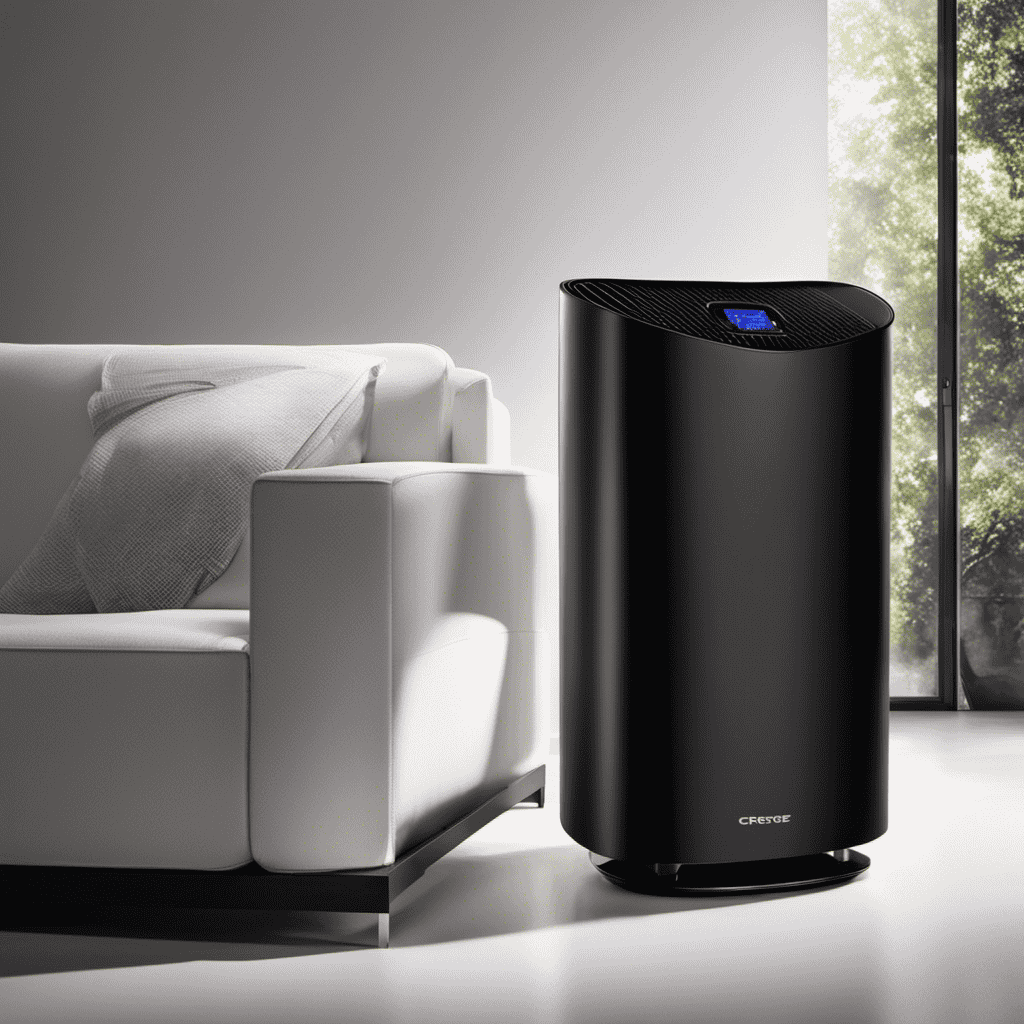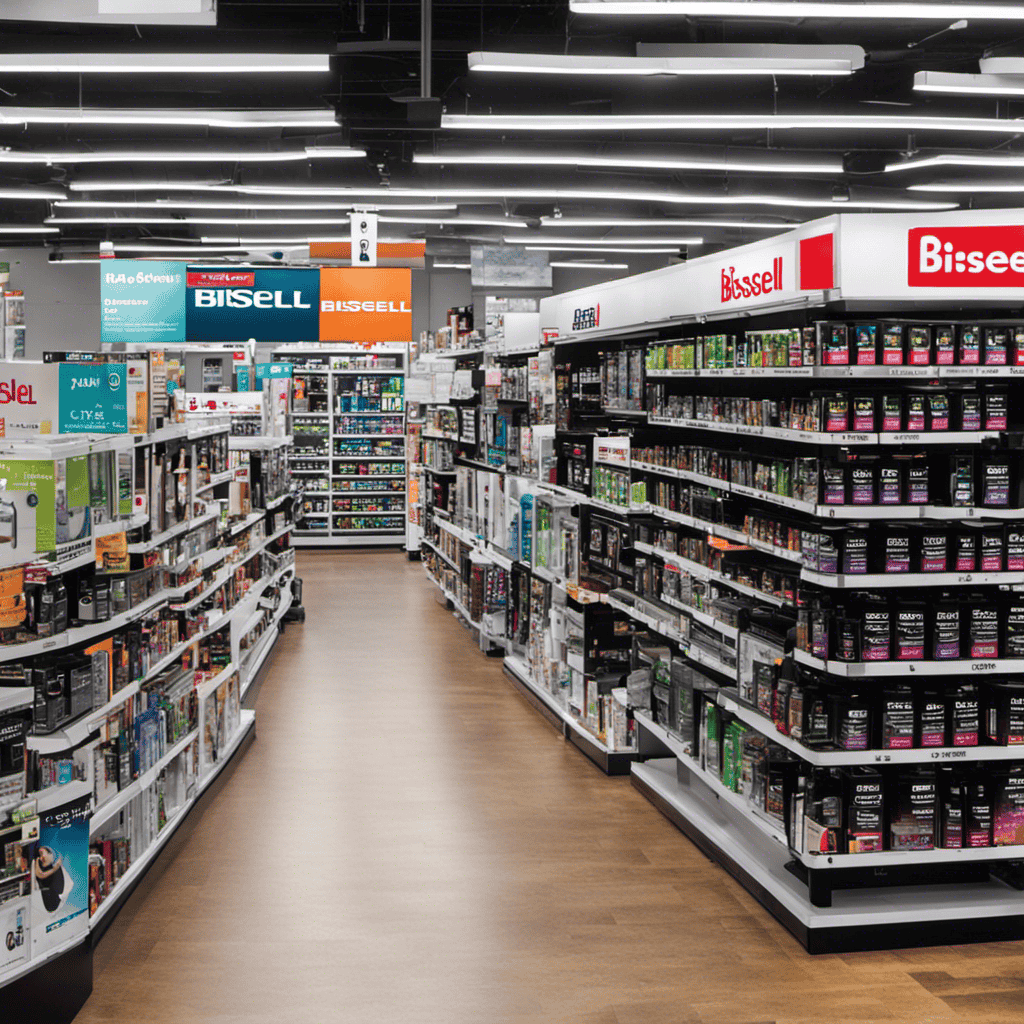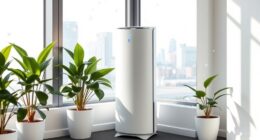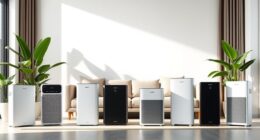Are you aware that indoor air can be up to five times more contaminated than outdoor air? As air pollution and allergies continue to increase, more individuals are opting for HEPA air purifiers to enhance the air quality they breathe.
But how do you measure the effectiveness of a HEPA air purifier? In this article, I will explore the various methods and factors to consider when evaluating the performance of these devices.
From understanding HEPA technology to monitoring indoor air quality, we will delve into the science behind measuring the effectiveness of a HEPA air purifier.
Key Takeaways
- HEPA technology filters out tiny particles in the air, including common allergens and harmful particles like bacteria and viruses.
- Testing air quality before and after using a HEPA air purifier is crucial to measure its effectiveness.
- Regular maintenance of the HEPA filter is essential for optimal performance.
- Clean Air Delivery Rate (CADR) measurements quantify the purifier’s ability to remove specific airborne pollutants, but they have limitations and should be carefully compared and evaluated.
Understanding HEPA Technology
HEPA technology is used to filter out tiny particles in the air, making it an effective solution for improving indoor air quality. The benefits of using a HEPA filter are numerous.
It can remove common allergens like dust mites, pollen, and pet dander, which can alleviate symptoms for those with allergies or asthma. Additionally, HEPA filters can capture and trap harmful particles such as bacteria, viruses, and even some volatile organic compounds.
To measure the effectiveness of a HEPA air purifier, testing the air quality before and after using the purifier is crucial. This can be done by monitoring the levels of pollutants, allergens, and particulate matter in the air.
Regular maintenance of the HEPA filter, such as cleaning or replacing it, is also essential to ensure optimal performance.
Airborne Particle Size and Filtration Efficiency
Airborne particle size greatly impacts the filtration efficiency of an air purifier. The ability of an air purifier to effectively remove particles from the air depends on the size of the particles it is designed to capture. Here are some key points to consider:
-
Particle size distribution: Airborne particles come in various sizes, ranging from larger particles like dust and pollen to smaller particles like bacteria and viruses.
-
Filter effectiveness: Different types of filters are designed to capture particles of specific sizes. HEPA filters, for example, are highly effective at removing particles as small as 0.3 micrometers.
-
Air quality standards: Air quality standards set by organizations like the EPA specify the maximum allowable concentration of certain particles in the air. Air purifiers must meet these standards to ensure effective air cleaning.
-
Testing methods: Filtration efficiency is often tested using standardized methods, such as the MERV rating system, which evaluates a filter’s ability to capture particles of different sizes.
Understanding the relationship between airborne particle size and filtration efficiency is crucial for selecting an air purifier that meets your specific air quality needs.
Clean Air Delivery Rate (CADR) Measurements
When evaluating the performance of HEPA air purifiers, it’s important to consider the limitations and accuracy of the Clean Air Delivery Rate (CADR) measurements.
CADR is a standardized metric that quantifies the purifier’s ability to remove specific airborne pollutants from a room within a given time frame. However, it’s essential to compare the CADR ratings of different models carefully.
Variations in testing conditions and methodologies can impact the accuracy of these measurements.
CADR Limitations and Accuracy
The CADR ratings have certain limitations and may not always accurately reflect the performance of an air purifier. While CADR testing provides a standardized method for evaluating air purifiers, it is important to consider the following factors:
-
Particle Measurement: CADR ratings are based on the removal of specific particle sizes, such as pollen, dust, and smoke. However, these ratings do not take into account the effectiveness of the air purifier in removing other pollutants like gases or odors.
-
Test Environment: CADR testing is conducted in a controlled laboratory setting, which may not accurately represent real-world conditions. Factors such as room size, airflow, and pollutant levels can significantly affect the performance of an air purifier.
-
Filter Replacement: CADR ratings are based on the performance of the air purifier with new filters. Over time, as filters become dirty and clogged, the CADR may decrease, affecting the overall performance of the purifier.
-
Individual Needs: CADR ratings provide a general indication of an air purifier’s performance, but individual needs may vary. Factors such as allergies, asthma, and specific pollutant concerns should also be considered when choosing an air purifier.
Comparing CADR of Models
To accurately compare CADR ratings of different models, look for information on the particle sizes that were tested for removal. This is crucial because the effectiveness of a HEPA air purifier depends on its ability to filter out specific particle sizes.
By comparing the particle sizes that were tested, you can determine which model is most effective in improving air quality.
Additionally, it is important to consider the HEPA filter effectiveness of each model. HEPA filters are designed to capture particles as small as 0.3 microns with an efficiency of 99.97%. Therefore, models with higher HEPA filter effectiveness will be more efficient in removing harmful pollutants from the air, leading to a significant improvement in air quality.
Testing for Allergens and Asthma Triggers
When it comes to finding reliable allergy relief, it’s important to first identify the indoor pollutants that may be triggering your symptoms. By understanding the specific allergens present in your environment, you can take targeted measures to reduce their presence and alleviate your symptoms.
Additionally, reducing asthma symptoms can also be achieved by identifying and minimizing exposure to asthma triggers, such as dust mites, pet dander, and mold.
Reliable Allergy Relief
For reliable allergy relief, it’s important to consider the effectiveness of a HEPA air purifier. These devices are designed to filter out airborne allergens and pollutants, providing a cleaner and healthier indoor environment. Here are some key points to consider:
-
HEPA filtration: A HEPA air purifier is equipped with a high-efficiency particulate air filter, which can capture up to 99.97% of particles as small as 0.3 microns. This includes pollen, pet dander, dust mites, and mold spores.
-
Reducing symptoms: By removing allergens from the air, a HEPA air purifier can help reduce allergy symptoms such as sneezing, coughing, and itchy eyes. It can also be beneficial for individuals with asthma, as it can minimize triggers that can lead to asthma attacks.
-
Long-term benefits: Using a HEPA air purifier consistently over time can have long-term benefits for allergy sufferers. It can help improve overall indoor air quality, leading to a reduction in allergy symptoms and potential health issues associated with prolonged exposure to allergens.
Considering the effectiveness of a HEPA air purifier is just the first step in achieving reliable allergy relief. The next section will focus on identifying common indoor pollutants and how they can be addressed.
Identifying Indoor Pollutants
Identifying common indoor pollutants can be a crucial step in creating a healthier and cleaner indoor environment. Indoor air pollutants can have significant health effects, ranging from minor irritation to more serious respiratory issues. To better understand the potential risks, it is important to be aware of the different types of pollutants commonly found indoors. The table below provides an overview of some common indoor pollutants and their associated health effects.
| Indoor Pollutant | Health Effects |
|---|---|
| Volatile Organic Compounds (VOCs) | Eye, nose, and throat irritation; headaches; dizziness |
| Mold and Mildew | Allergic reactions; respiratory issues |
| Tobacco Smoke | Respiratory problems; increased risk of cancer |
| Dust and Dust Mites | Allergies; asthma exacerbation |
| Pollen | Allergic reactions; asthma exacerbation |
Asthma Symptom Reduction
Asthma is a chronic respiratory condition that affects millions of people worldwide. One of the key aspects of asthma management is reducing symptoms and improving respiratory health.
Several studies have shown that using a HEPA air purifier can be beneficial for individuals with asthma. Here are some ways in which these devices can help:
-
Filtering out allergens: HEPA filters can capture common asthma triggers such as dust mites, pollen, pet dander, and mold spores.
-
Removing airborne irritants: Air purifiers can effectively remove smoke, volatile organic compounds (VOCs), and other pollutants that can trigger asthma symptoms.
-
Improving indoor air quality: By continuously circulating and filtering the air, HEPA purifiers can help maintain clean and fresh indoor air, reducing the risk of asthma attacks.
-
Enhancing sleep quality: Cleaner air can lead to better sleep, which is crucial for managing asthma symptoms.
Overall, incorporating a HEPA air purifier into asthma management can contribute to better respiratory health and improved quality of life for individuals with asthma.
Monitoring Indoor Air Quality (IAQ
To monitor indoor air quality (IAQ), you can use a variety of sensors and devices that provide real-time data on the air pollutants present in your environment. IAQ monitoring has become increasingly popular in recent years, as people have become more aware of the impact of air pollution on their health. One effective way to improve IAQ is by using HEPA air purifiers. These purifiers are designed to remove harmful particles from the air, such as dust, pollen, and pet dander. They have been proven to be highly effective in reducing indoor air pollution and improving overall air quality. The benefits of HEPA air purifiers include reducing allergy symptoms, improving respiratory health, and creating a cleaner and healthier living environment. Transitioning into the next section, assessing noise levels and fan speeds is another important aspect to consider when evaluating the effectiveness of HEPA air purifiers.
| IAQ Monitoring Trends | Benefits of HEPA Air Purifiers |
|---|---|
| Increasing awareness of the importance of IAQ | Removal of harmful particles from the air |
| Growing demand for IAQ monitoring devices | Reduction in allergy symptoms |
| Advancements in sensor technology | Improved respiratory health |
| Integration of IAQ monitoring with smart home systems | Cleaner and healthier living environment |
| Emphasis on preventive measures for better IAQ | Increased overall air quality |
Assessing Noise Levels and Fan Speeds
Assessing noise levels and fan speeds is crucial when evaluating how well HEPA air purifiers are working. By measuring these factors, we can determine the efficiency of the device in cleaning the air and ensuring a comfortable living environment.
There are several key aspects to consider when assessing noise levels and fan speeds:
- Noise levels: The purifier should operate quietly to avoid disturbance, especially during the night.
- Fan speeds: Different fan speeds allow for customization based on the specific air quality needs and room size.
- Assessing filter effectiveness: Regularly checking the filter’s performance is essential to ensure optimal air purification and prevent contaminants from re-circulating.
- Evaluating user satisfaction: Gathering feedback from users regarding noise levels and fan speeds can provide valuable insights into overall satisfaction and effectiveness.
Understanding these factors will help us determine the effectiveness of HEPA air purifiers and assess the user experience.
Transitioning into the subsequent section, the evaluation of filter replacement frequency is another important aspect to consider.
Evaluating Filter Replacement Frequency
When evaluating filter replacement frequency, it’s important to regularly monitor the condition of the filters in order to maintain optimal air purification and prevent the accumulation of contaminants. By evaluating the performance of the filters, we can ensure that our air purifier is working efficiently and effectively. Additionally, conducting a cost analysis can help us determine the most cost-effective filter replacement schedule. To assist in this evaluation, I have created a table highlighting the recommended filter replacement frequencies for different types of contaminants. This table allows us to objectively analyze the performance of our filters and make informed decisions regarding their replacement. By considering both the effectiveness and cost implications, we can ensure that our air purifier continues to provide clean and healthy air in the most efficient manner.
| Contaminant Type | Recommended Filter Replacement Frequency |
|---|---|
| Pollen | Every 3 months |
| Dust | Every 3-6 months |
| Pet Dander | Every 3-6 months |
| Mold Spores | Every 6-12 months |
| Smoke | Every 6-12 months |
This table serves as a valuable tool for evaluating the performance of our air purifier and conducting a cost analysis to determine the optimal filter replacement frequency. By following these recommendations, we can ensure that our air purifier continues to provide efficient and effective air purification while also minimizing unnecessary costs.
Comparing Energy Efficiency and Operating Costs
By comparing energy efficiency and operating costs, we can determine the most cost-effective option for maintaining clean air in our space. When evaluating air purifiers, it is important to consider their energy consumption and maintenance costs. Here are some factors to consider:
-
Energy consumption: Look for an air purifier that is energy-efficient and has a low power consumption. This will not only save you money on electricity bills but also reduce your environmental impact.
-
Maintenance costs: Consider the cost of replacing filters and other consumables. Some air purifiers require frequent filter replacements, which can add up over time. Look for models with long-lasting filters or washable filters to minimize maintenance costs.
Considering Room Size and Coverage Area
To ensure that the air purifier effectively cleans the air in your space, consider the size of the room and the coverage area it can handle. Room size considerations and coverage area factors play a crucial role in determining the efficiency of an air purifier. A smaller purifier may struggle to effectively clean the air in a larger room, while a larger purifier may be unnecessary and consume more energy in a smaller space. It is important to match the purifier’s coverage area with the size of your room to optimize its performance. Here is a table summarizing different room sizes and their corresponding recommended coverage areas:
| Room Size | Recommended Coverage Area |
|---|---|
| Small (up to 150 sq. ft.) | 150 sq. ft. |
| Medium (up to 300 sq. ft.) | 300 sq. ft. |
| Large (up to 500 sq. ft.) | 500 sq. ft. |
| Extra Large (over 500 sq. ft.) | Varies based on specific needs |
Considering these room size considerations and coverage area factors will help you select an air purifier that effectively cleans the air in your space. Now, let’s delve into real-life user reviews and experiences to gain further insights.
Real-Life User Reviews and Experiences
User reviews and experiences can provide valuable insights into the performance of different air purifiers. By examining these reviews, we can gain a better understanding of user satisfaction and the long-term performance of air purifiers.
Here are some key points to consider:
-
User satisfaction: Reviews often highlight whether users are happy with the air purifier’s performance in terms of air purification, noise levels, and ease of use.
-
Effectiveness: Real-life experiences can shed light on the actual effectiveness of the air purifier in removing allergens, odors, and pollutants from the air.
-
Durability: Long-term performance is an important factor to consider. User reviews can provide information on how well the air purifier maintains its efficiency over time.
-
Maintenance: Reviews often mention the ease or difficulty of maintaining the air purifier, such as changing filters or cleaning the device.
Analyzing user reviews and experiences can offer valuable insights into the overall performance and effectiveness of different air purifiers in real-life scenarios.
Frequently Asked Questions
Are There Any Potential Health Risks Associated With Using a HEPA Air Purifier?
I haven’t found any potential risks or health hazards associated with using a HEPA air purifier. However, it’s important to choose a reputable brand and regularly maintain the filters for optimal performance.
Can a HEPA Air Purifier Effectively Remove Odors and Harmful Gases From the Air?
A Hepa air purifier effectively removes odors and harmful gases from the air. Its efficiency lies in the use of Hepa filters, which are designed to capture and trap tiny particles, including pollutants and allergens.
How Long Does It Take for a HEPA Air Purifier to Noticeably Improve Indoor Air Quality?
I measure the effectiveness of a HEPA air purifier by observing how quickly it improves indoor air quality. It is important to note the benefits of a HEPA air purifier, such as removing pollutants and allergens from the air.
Can a HEPA Air Purifier Help Reduce the Spread of Airborne Viruses and Bacteria?
Using a HEPA air purifier can help reduce the spread of airborne viruses and bacteria. Its filtration system captures and traps these harmful particles, preventing them from circulating in the air and potentially infecting others.
What Maintenance and Cleaning Is Required for a HEPA Air Purifier to Function Effectively?
To ensure a hepa air purifier functions effectively, regular maintenance and cleaning are necessary. Maintenance requirements may include changing filters, cleaning the unit, and checking for any malfunctions. Using proper cleaning techniques will help optimize its performance.
Conclusion
In conclusion, the effectiveness of a HEPA air purifier can be measured through various factors.
Just like a lighthouse guides ships safely through turbulent waters, a HEPA air purifier acts as a beacon of clean air in our homes.
By understanding the technology, testing for allergens, evaluating filter replacement frequency, and considering room size and coverage area, we can ensure that our air purifiers are working efficiently and effectively.
Real-life user reviews and experiences also provide valuable insights.
So let your HEPA air purifier be your guiding light towards a healthier and cleaner indoor environment.










